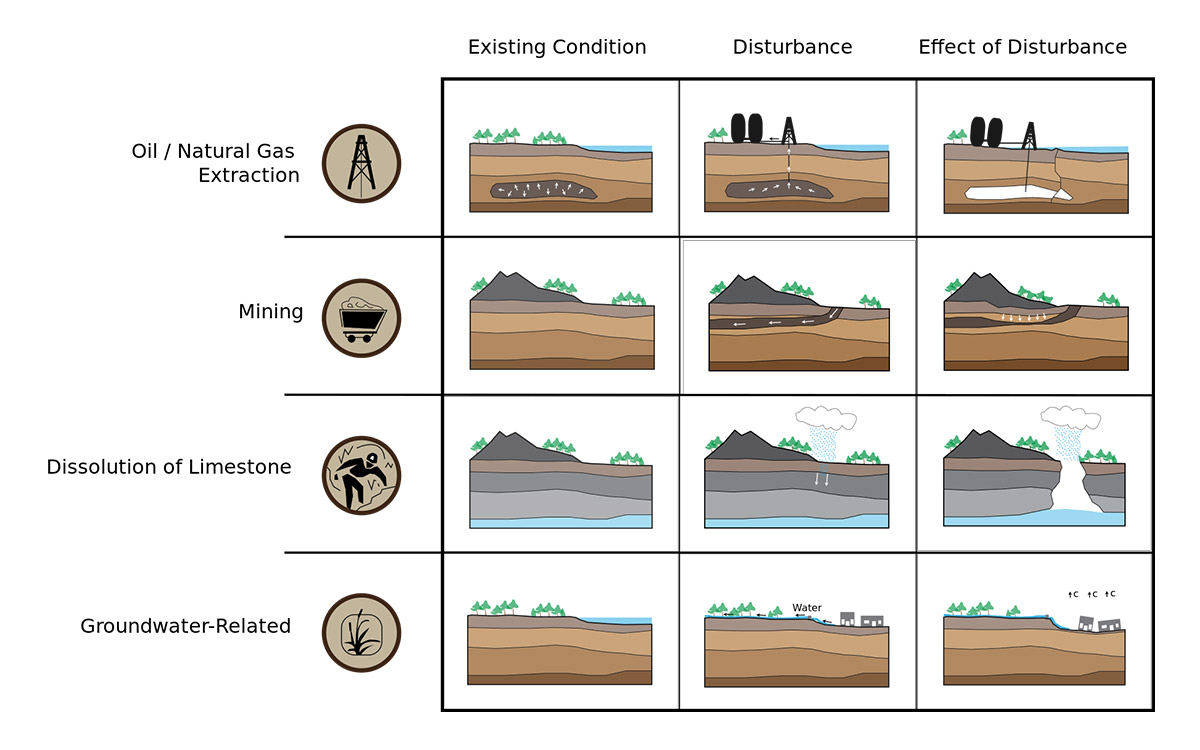Subsidence
For more information about Texas specific subsidence please visit the Aquifer Vulnerability Report
Background
 Subsidence is a multi-faceted problem that affects groundwater and surface water systems, transportation, utilities, and building infrastructure.
Subsidence is a multi-faceted problem that affects groundwater and surface water systems, transportation, utilities, and building infrastructure.
According to the National Oceanic and Atmospheric Administration (NOAA), subsidence is "sinking of the ground because of underground material movement and it is most often caused by the removal of water, oil, natural gas, or mineral resources out of the ground by pumping, fracking, or mining activities."

Subsidence Working Group
Purpose
Land deformation/subsidence can be measured via various surveying techniques using Global Positioning System (GPS), Satellite Interferometric Synthetic Aperture Radar (InSAR), or other methods. Each of these methods creates a large amount of data. Recently, researchers and various agencies have collected subsidence data in a variety of ways. However, it is not common to share the collected data with other stakeholders. This lack of sharing is understood to be due in part to the absence of a centralized sharing platform. After conducting a subsidence workshop (September 2022) and survey led by the Texas Integrated Flooding Framework (TIFF) project, many researchers and practitioners were interested in improved sharing of subsidence data and seeing what data was available on a statewide basis. The TWDB sees significant value in a centralized dashboard that contains subsidence datasets from various sources. This dashboard could be used in the future by local entities to submit and store their subsidence related data, models, and consideration as input for development of a future predictive subsidence tool across the state of Texas. This predictive tool could be an input into future flood modeling across the state of Texas looking at land use and terrain changes for the future. This data sharing will benefit Texans with data for groundwater management plans developed by groundwater conservation districts, research on sea level rise impacts/flooding, research on land use changes, and other topics..
The data requires geographic location in relation to specific projects that are developed and included in each dataset. The TWDB Subsidence Working Group (a cross-divisional group of TWDB staff from the Surface Water, Flood Science and Community Assistance, and Groundwater divisions) is working on trying to fill this gap by supporting efforts to facilitate creating and sharing data and maintaining the data in a centralized subsidence dashboard. For more information on what the TWDB Subsidence Working Group is doing to advance subsidence research, please contact:
- Alberto Jimenez, Groundwater Department
- Amin Kiaghadi, Coastal Science Department
If you are interested in presenting or collaborating, please contact us.
Relevance
- The TWDB is tasked with guiding the development of a statewide water resource data collection and dissemination network. (Texas Water Code § 16.012.)
- Groundwater conservation districts are required to develop a goal to control and prevent subsidence, where applicable, in groundwater management plans (Texas Water Code § 36.1071). The TWDB reviews groundwater management plans for administrative completeness.
- In developing desired future conditions, groundwater conservation districts within groundwater management areas are required to consider the impacts to subsidence in a desired future condition explanatory report (Texas Water Code § 36.108). The TWDB reviews explanatory reports for administrative completeness.
Actions
-
The Texas Integrated Flooding Framework (TIFF) is a multi-state/federal agency effort funded by Government Land Office (GLO)/U.S. Department of Housing and Urban Development (HUD) with funding going towards three active partners - TWDB, United States Army Corps of Engineers (USACE), and United States Geological Survey (USGS) to improve the framework within which riverine and coastal flooding is considered in Texas. The TWDB and the steering committee members of the TIFF hosted a virtual subsidence workshop on September 7, 2022. The results/summary of the workshop are below:
- Our goal of the workshop was to improve statewide coordination for subsidence data collection and sharing.
- We gathered insights from subsidence experts about acquisition and resource needs for advancing subsidence data in Texas.
- 177 people participated.
- There were nine pre-recorded presentations with discussion and question-and-answer among the presenters and participants.
- Many researchers and practitioners were interested in improved sharing of subsidence data and seeing what data was available on a statewide basis.
- Per workshop participants interests and suggestions, the TWDB developed Subsidence Brown Bag presentation series for Winter/Spring 2023 and 2024. Please see the presentation schedule below. The list of these talks are provided in "Webinar Topics" section.
Webinar Topics
2023
- January 12th:
- The Land Surface-Groundwater Nexus: A case study, the science, and the big picture by John Ellis from USGS/Interra
- February 9th:
- HGSD Data Overview by Ashley Greuter from Harris-Galveston Subsidence District
- March 9th:
- New Preconsolidation Heads Following the Long-Term Hydraulic-Head Decline and Recovery in Houston, Texas by Dr. Bob Wang University of Houston
- April 13th:
- Spatial and temporal variations in groundwater levels of the Gulf Coast Aquifer System: Implications for land subsidence by Dr. Shuhab Khan from University of Houston
- May 11th:
- Latest InSAR subsidence results along the Gulf Coast and how we were able to integrate these satellite observations to storm surge models (developed by Clint Dawson's team) to analyze flood risks among different communities by Dr. Ann Chen from University of Texas at Austin
- June 8th:
- Surface Water Transmission Lines Needed to Convert Areas from Groundwater to Surface Water by Michael Ereti from City or Houston
- July 13th:
- The history of the National Geodetic Survey estimating subsidence in the Houston-Galveston Region by Dave Zilkoski
- August 10th:
- GEOGULF Model by John Ellis from Interra
- September 13th:
- Measuring Vertical Land Motion for Sea Level Rise by David Bekaert from NASA
- October 12th:
- California Department of Water Resource's Land Subsidence Monitoring and Reporting by Benjamin Brezing and Steven Springhorn
- November 9th:
- Measuring, modelling and projecting coastal land subsidence by Dr. Manoochehr from Virginia Tech
2024
- February 8th:
- Investigating the Potential for Subsidence Due to Groundwater Pumping from Texas Aquifers by Mike Keester from R. W. Harden & Associates, Inc.,
- March 14th:
-
Texas Coastal Subsidence Measurements - InSAR, Tide Gauges, GPS, and Benchmarks' by:
- UTCBI Dr. Richard Smith - Executive Director of the Conrad Blucher Institute for Surveying and Science at Texas A&M University-Corpus Christi (TAMU-CC)
- Dr. Tianxing Chu - Assistant Professor in Geospatial Systems Engineering at Texas A&M University-Corpus Christi (TAMU-CC), Associate Director of the Measurement Analytics (MANTIS) Lab with the Conrad Blucher Institute for Surveying and Science at Texas A&M University-Corpus Christi
- Dr. Philippe Tissot - Chair for Coastal Artificial Intelligence with the Conrad Blucher Institute for Surveying and Science at Texas A&M University-Corpus Christi
- Ms. Seneca Holland - Geospatial Analyst at the Conrad Blucher Institute for Surveying and Science at Texas A&M University-Corpus Christi (TAMU-CC)
- April 11th:
- InSAR Data Processing Overview by Adrian Cohane from TRE ALTAMIRA Inc.
- May 9th:
- TBD updates coming
- June 13th:
- One Bad Hazard Exacerbates Another: Sinking Land and Rising Seas along the Coasts of the United States by Dr. Leonard Osadebamwen Ohenhen, Virginia Tech
- July 11th:
- Rescheduled for December 12th
- August 8th:
- Rescheduled for February 13, 2025
- September 12th:
- Subsidence Pattern According to Crop Type and Managing Groundwater at Fine Scales by Morgan Levy from University of California San Diego
- October 10th:
- Using Subsidence to inform Sea Level Rise Models as Part of Coastal Resiliency Master Plan by Dr. Jim Gibeaut from Harte Research Institute for Gulf of Mexico Studies
- November 14th:
- Advancing Our Understanding: Recent Research Focused on Subsidence in the Greater Houston Region by Ashley Greuter from Harris Galveston Subsidence District
- December 5th:
- Dynamics of Local Sea Level Rise in the Gulf of Mexico: Historical Evolution, Instantaneous Budget, and the Impacts of Climatic and Anthropogenic Factors by Ashraf Rateb from University of Texas at Austin
2025
- February 13th:
- Global Land Subsidence Mapping Reveals Widespread Loss of Aquifer Storage Capacity by Fahim Hasan from Colorado State University
Webinar Videos are available by request please email: Alberto.Jimenez@twdb.texas.gov or Amin.Kiaghadi@twdb.texas.gov